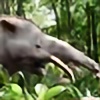HOME | DD
 LordGeekington — Building a Better Basilosaurus
by-nc
LordGeekington — Building a Better Basilosaurus
by-nc

Published: 2012-09-26 23:51:23 +0000 UTC; Views: 2223; Favourites: 33; Downloads: 111
Redirect to original
Description
The fossil whale _Basilosaurus_ was certainly an extreme animal but I suspect reports of it being "eel-like" or "snake-like" are very much exaggerated.Curiously, one problem with most _Basilosaurus_ reconstructions is that they're too short. Kellogg's 1936 reconstruction - which I've modified here - was based off incomplete _B. cetoides_ specimens; near-complete _B. isis_ have about 10 more vertebrae, including several of the long-bodied lumbars. _Dorudon atrox_ have a similar count, which further supports this revision. All in all, the revised _Basilosaurus cetoides_ wound up being 20% longer than Kellogg's original.
Reconstructions of _Basilosaurus_ often give it eel-like flexibility, but this seems dubious. _Basilosaurus_ doesn't really have that many vertebrae - 66-70 compared with 40-100 for extant cetaceans - and the long-bodied, blocky shape suggests they were fairly rigid. However, an extensive portion of the vertebral column is taken up by lumbars and lumbarized thoracics and caudals, so more of the body may have been involved with producing thrust than modern cetaceans. Perhaps instead of eels _Basilosaurus_ should be compared with pikes and gars. 15 meter long cetaceous hyper-gars, now there's a mental image...
_Basilosaurus_ had flukes but, like _Dorudon_, lacked a proper caudal peduncle (extreme lateral narrowing prior to fluke). I noticed that Dugongs with a (near-) peduncle and Manatees without peduncles have drastically different fluke shapes, with the former being whale-like and the latter being paddle-like. Thus, I portrayed _Basilosaurus_ with a more rounded, paddle-like fluke shape than modern whales, which also ties in with the gar comparison.
Soft tissue is a challenge. Vertebral spines in modern cetaceans don't appear to come anywhere near the dorsal surface, so _Basilosaurus_ also certainly had layers of muscle and blubber on its back. Since _Basilosaurus_ has very low spines compared to extant whales, I made the coating fairly modest. Extant cetaceans don't seem to have a considerable amount of tissue beneath the sternum, so I used this to roughly predict how deep the body was. Extant cetaceans have vast amounts of tissue after the ribcage, so I portrayed _Basilosaurus_ similarly. It wound up looking a bit like _Berardius_.
So anyways, I'm not really done with this (I'm never 'done' with anything really) and I'm sure I'll think of better morphology later. The head still bugs me, and I have quite a bit of difficulty imagining what's happening in the nasal area in particular, since the morphology there could have given rise to both the melon of toothed whales and splash-guard of baleen whales.
Related content
Comments: 8

👍: 0 ⏩: 0

Excellent, how much do you estimate Basilosaurus weight ?
👍: 0 ⏩: 1

Good question. If we assume 15 meters was a normal-ish length we can directly compare it to Fin and Sei Whales, which are about ~20 tonnes at this size (not accounting for blood loss). Basilosaurus was probably more slender than rorquals, although it's hard to say by how much. So, uh, if I had to broadly guess, something like 10–20 tonnes for an average individual. Maybe Bestiarius could use his model to get a better estimate...
fav.me/d722orl
👍: 0 ⏩: 1

Good. Somehow, one ton per metre seems realistic so.
👍: 0 ⏩: 0

Yeah... it was totally on backwards. Thanks for catching that!
👍: 0 ⏩: 1

Very interesting points, specially the idea that definitively the basilosaurids are not like giant serpents, but gars as you suggesting here.
By the way... the hindlimbs are pointing backwards?
👍: 0 ⏩: 0



















